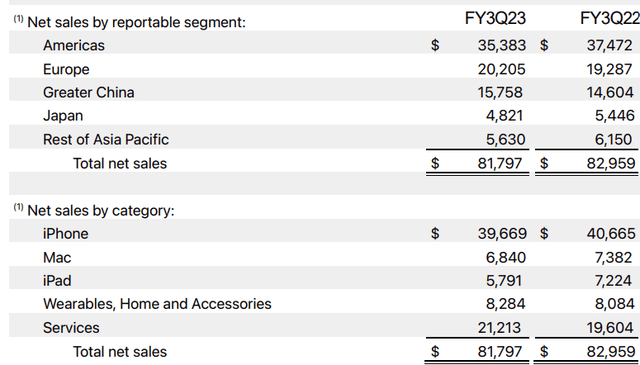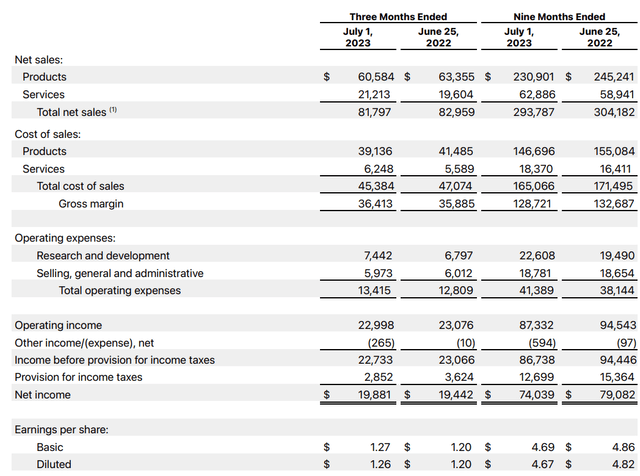Summary:
- The company has multiple levers to pull on the cost front to ensure that profitability and margins are maintained despite the challenging macroeconomic environment.
- Apple’s iPad, Mac, and iPhone segment remains difficult in the near term, posing a weakness in revenues in the meantime.
- The US smartphone market is likely to be a headwind to iPhone revenues as a result of inflation, weak consumer demand, and an elevated inventory position.
- AAPL’s capital return to shareholders remains attractive for long-term investors due to its massive net cash position and strong cash generation capabilities.
- At 29x FY2024 P/E, the risk-reward is not attractive for investors to enter into the name.
Wirestock
I have looked deep into Apple’s (NASDAQ:AAPL) recent FY3Q23 quarter, and in this article, I will provide an analysis and my opinions about the quarter and what it means for Apple going forward.
The current quarter does highlight to me that in the near-term, Apple’s topline will face some headwinds. This is a result of a difficult macroeconomic environment that continues to affect multiple segments of the company, particularly so for the iPhone segment in the US. In my view, the smartphone market in the US will continue to see the headwinds that it has been facing for multiple quarters now, which is a result of consumers delaying purchasing a new smartphone given the uncertain macroeconomic climate, which I will further elaborate below.
On the other hand, I think we will see management focus more on what they can control, and that is the cost side of the equation. By focusing on spending, management is looking to improve the profitability of the company by leveraging on multiple levers including dialing back on SG&A spend, amongst others, highlighted below. I am of the opinion that this remains to be a part of the business that the management team will be focusing on in the near-term to ensure that margins can be maintained in the near-term while revenues are somewhat weak.
I will first elaborate more on my view that Apple is focusing on cost discipline in the near-term.
Apple is focused on cost discipline
As evident from the recent FY3Q23 quarter, management showed that they continued to be disciplined on costs and pull levers on this front to ensure that spending is in-line with the macroeconomic environment and the near-term growth in revenues.
While the macroeconomic environment and demand environment has been uncertain, with weakness in some pockets in its business including the iPhone segment in the US, management has been focused on cost savings and being deliberate in their spending in the current environment.
Management stated that they have been deliberate in terms of controlling their spend and the team has looked across the entire company to run the company more efficiently. In addition to that, Apple has slowed hiring in multiple areas within its business.
In addition, the company has been focusing on the key areas of spend, with R&D costs growing at 9% from the prior year, faster than the rest of the company, while SG&A costs actually fell about 1% in the current quarter compared to the prior year. This highlights that the company continues to invest in product development and innovation.
I think that this will continue to be a driver for future near-term earnings as management is able to control the expenses side of the equation by slowing the growth in expenses to ensure that their spending is in-line with the uncertainty in the macro environment.
Weakness in iPhone, Macs and iPad to continue in the near term
In my view, in the FY3Q23 quarter, there was further evidence that we will see weakness in the iPhone, Macs and iPad segment in the near-term.
Why is this so?
When looking at the individual segments, the company’s largest segment, the iPhone segment, was below consensus by 1% in the quarter, down 2% compared to the prior year, to $39.7 billion. iPad was weak as it fell 20% from the prior year to $5.8 billion, 10% below consensus estimates. Macs segment revenue also fell 7% from the prior year to $6.8 billion, 9% above consensus, but commentary around Macs was poor, as elaborated in the guidance section below.
Other segments like wearables and services segment were in-line with expectations, growing 2% and 8% from the prior year, to $8.3 billion and $21 billion respectively.
The US continued to face headwinds in the quarter but on the other hand, the Greater China region was stronger than expected. By geographical segments, the revenue contribution from the Greater China region outperformed with 8% growth from the prior year to $16 billion, while the revenue contribution from the Americas region underperformed with revenues falling 6% from the prior year to $40 billion. This strength we are seeing from the Greater China region is a result of strong recovery after covid restrictions were relaxed, while the weakness in the US was a result of a difficult smartphone market in the region.
CEO Time Cook continued to sound confident in the performance across the world, and had this to say about the geographical performance of Apple in the earnings call:
If you sort of step around the world, we did exceptionally well in emerging markets last quarter and even better on a constant currency basis. And so emerging markets were a strength.
If you look at China, in China, we went from a negative 3% in Q2 to a plus 8% in Q3. And so, in China, we had an acceleration.
If you look at the US, there was also a slight acceleration sequentially, although the Americas is still declining somewhat year-over-year, as you can see on the data sheet. The primary reason for that is that it’s a challenging smartphone market in the US currently.
Europe saw a record quarter for the June quarter.
And so, some really good signs in most places in the world.
Revenue segment performance (Apple)
In my view, the commentary around the US suggests the near-term outlook for iPhone revenues remains challenging as a result of a weak smartphone market.
The weakness in the US smartphone market is of course not unique to Apple, but the reason for the weakness includes weak consumer demand, high inflation and elevated inventory positions in the US.
Thus, I am of the opinion that with consumer demand remaining weak, inflation remaining high and inventory positions still in an adjustment phase, the near-term outlook for the US smartphone market remains bleak.
High level snapshot of the FY3Q23 quarter
For FY3Q23, Apple reported revenues of $82 billion, down about 1% from the prior year. This met consensus expectations of about $82 billion.
Gross margins came in at 44.5%, and at the high end of its guide of between 44% to 44.5%. Product gross margin came in at 35.4% while services gross margin came in at 70.6%. The 44.5% overall company level gross margin was a record for the June quarter and up 20 basis points from the prior quarter, largely driven by a larger contribution from Services segment this quarter, as well as improved cost savings. This was partially offset by a loss of leverage in the quarter. For the product gross margin of 35.4%, this was down 130 basis points sequentially as a result of mix and a loss of leverage.
Apple’s operating expenses for the quarter came in at $13.4 billion, lower than the low end of the guidance range as management has been focused on cost discipline to ensure that the company spends deliberately on innovation and new production development.
Apple’s EPS came in at $1.26, 6% higher than consensus estimates of $1.19 EPS.
Guidance implies a challenging environment
The guidance from management does highlight some near-term challenges for Apple in the near-term.
Firstly, Apple expects that the macroeconomic headwinds will likely continue to have a negative impact on the company’s next quarter revenues. As a result, they are guiding for a similar year-on-year growth in FY4Q23 and 2-percentage point negative impact to the next quarter’s revenues as a result of foreign exchange headwinds. It is also important to note that the guidance for FY4Q23 assumes that the macroeconomic outlook does not deteriorate from where we are today.
Secondly, there are challenges expected in multiple segments of the company. In particular, the iPad and Mac segments are particularly challenging. Management expects revenues for the iPad and Mac segments are expected to decline by double digit levels when compared to the prior year as a result of difficult compares. In particular for Mac, in FY3Q22, there was supply disruptions due to factory shutdowns and Apple was subsequently able to fulfill the significant pent-up demand in FY4Q22. Thus, the compare for Mac is particularly tough for FY4Q23.
Solid cash generation and capital management
Apple continued to execute well in terms of cash generation and capital management.
For reference, in the quarter, Apple generated cash from operations of $26 billion and returned $24 billion to shareholders. This included $4 billion in dividends and $18 billion in share repurchases.
As a result of the cash generated from the quarter and the capital returned to shareholders, Apple currently has $166 billion in cash and marketable securities. After repaying $7.5 billion in debt and issuing $5.2 billion in new debt, the company currently has a debt position of $109 billion.
Thus, Apple is currently at a net cash position of $57 billion as of the FY3Q23 quarter.
Management stated in the earnings call that they continue to target reaching net cash neutral position in the long-term and continues to see value in its stock.
Given that management continues to see value in its stock, I am of the opinion that Apple will continue to return capital to shareholders in the form of share repurchases and dividends.
This will continue to benefit holders of the stock in the longer term as Apple continues to have a strong net cash position and still generates solid cash from operations from its business.
Valuation
At 29x FY2024 P/E, I think the risk reward in entering Apple at current levels is not attractive. As a result, I am neutral on Apple at the current moment.
The company remains a quality, long-term investment for those currently holding the stock given the long-term capital return from the huge net cash position accumulated over the years.
Conclusion
The near-term outlook is challenging for Apple, in my view.
While the company can focus on its costs by decelerating the growth of its expenses in this uncertain and challenging macroeconomic environment, there remains weakness in multiple segments of Apple’s business.
The near-term weakness in the smartphone market in the US remains a majority source of weakness for the business and brings near-term uncertainty to the business.
In addition to that, the iPad and Mac segment looks difficult in the near-term as there are difficult compares, and the macroeconomic environment is causing weakness in these segments.
The company continues to spend on R&D to ensure that it continues to invest in its long-term ambitions, which is positive for the company as the company will emerge from this stronger than before.
On top of that, I also think that Apple continues to be a solid cash generation machine, with strong return of capital to shareholders, which will continue to benefit long-term shareholders.
I am of the view that Apple remains a quality, long-term investment for those currently holding the stock given the long-term capital return from the huge net cash position accumulated over the years.
However, at 29x FY2024 P/E, I think the risk reward in entering Apple at current levels is not attractive given the headwinds and uncertainty surrounding the business today.
Analyst’s Disclosure: I/we have no stock, option or similar derivative position in any of the companies mentioned, and no plans to initiate any such positions within the next 72 hours. I wrote this article myself, and it expresses my own opinions. I am not receiving compensation for it (other than from Seeking Alpha). I have no business relationship with any company whose stock is mentioned in this article.
Seeking Alpha’s Disclosure: Past performance is no guarantee of future results. No recommendation or advice is being given as to whether any investment is suitable for a particular investor. Any views or opinions expressed above may not reflect those of Seeking Alpha as a whole. Seeking Alpha is not a licensed securities dealer, broker or US investment adviser or investment bank. Our analysts are third party authors that include both professional investors and individual investors who may not be licensed or certified by any institute or regulatory body.
Outperforming the Market
Outperforming the Market is focused on helping you outperform the market while having downside protection during volatile markets by providing you with comprehensive deep dive analysis articles, as well as access to The Barbell Portfolio.
The Barbell Portfolio has outperformed the S&P 500 by 97% in the past year through owning high conviction growth, value and contrarian stocks.
Apart from focusing on bottom-up fundamental research, we also provide you with intrinsic value, 1-year and 3-year price targets in The Price Target report.
Join us for the 2-week free trial to get access to The Barbell Portfolio today!

